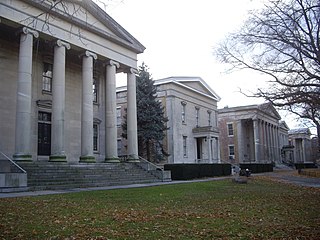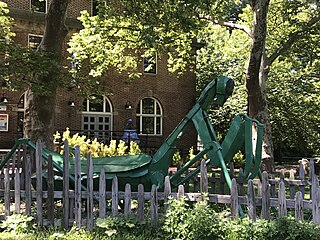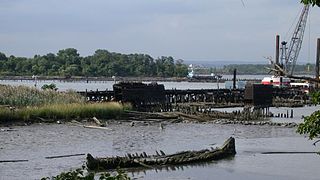
New Brighton is a neighborhood located on the North Shore of Staten Island in New York City. The neighborhood comprises an older industrial and residential harbor front area along the Kill Van Kull west of St. George. New Brighton is bounded by Kill Van Kull on the north, Jersey Street on the east, Brighton and Castleton Avenues to the south, and Lafayette Avenue and Snug Harbor Cultural Center to the west. It is adjacent to St. George to the east, Tompkinsville to the south, and West New Brighton to the west.

The term North Shore is frequently applied to a series of neighborhoods within the New York City borough of Staten Island.

Sailors' Snug Harbor, also known as Sailors Snug Harbor and informally as Snug Harbor, is a collection of architecturally significant 19th-century buildings on Staten Island, New York City. The buildings are set in an 83-acre (34 ha) park along the Kill Van Kull in New Brighton, on the North Shore of Staten Island. Some of the buildings and the grounds are used by arts organizations under the umbrella of the Snug Harbor Cultural Center and Botanical Garden.

Randall Manor is a neighborhood on the North Shore of Staten Island, one of the five boroughs of New York City, United States. The neighborhood is bound by Bard Avenue to the West, Henderson Avenue to the North, Forest Avenue to the South, and Lafayette Avenue to the East. It used to be part of Elliottville.

The Brooklyn Children's Museum is a children's museum in the Crown Heights neighborhood of Brooklyn in New York City. Founded in 1899, it is the first children's museum in the United States – and according to some, the first one worldwide. It is unusual in its location in what is predominantly a residential area. Housed in a multi-level underground gallery, the museum underwent an expansion and renovation to double its space, reopened on September 20, 2008, and became the first green museum in New York City.

Livingston is a name sometimes applied to the northeastern portion of West Brighton, a neighborhood located on the North Shore of the New York City borough of Staten Island.

The Children’s Museum of Manhattan is located on the Upper West Side of Manhattan in New York City. It was founded by Bette Korman, under the name GAME, in 1973. The museum became the Children’s Museum of Manhattan in the 1980s and moved to its current location on West 83rd Street in 1989. In 2018, the museum announced a plan to relocate to a larger space on 96th Street and Central Park West.

Flower mantises are praying mantises that use a special form of camouflage referred to as aggressive mimicry, which they not only use to attract prey, but avoid predators as well. These insects have specific colorations and behaviors that mimic flowers in their surrounding habitats.

The Sports Museum of America (SmA) was the United States' first national sports museum dedicated to the history and cultural significance of sports in America. It opened in May 2008 and closed less than nine months later, in February 2009.

The New York Chinese Scholar's Garden is part of the Staten Island Botanical Garden, located in the Snug Harbor Cultural Center. Materials were shipped to Staten Island in the spring of 1998, when a team of 40 Chinese artists and artisans from Suzhou constructed the garden. It opened in June of 1999.

Staten Island Museum is Staten Island’s oldest cultural institution, and the only remaining general interest museum in New York City.
The Rose Museum is a small museum dedicated to the history of Carnegie Hall in Manhattan, New York City. The museum, which opened in 1991, is located at 154 West 57th Street, on the second floor of Carnegie Hall. It was funded by the Susan and Elihu Rose Foundation and includes more than 2,500 feet of archives and more than a century of concert programs. The plan when the museum opened was to supplement its permanent collection with a series of rotating exhibits. The museum also focuses on the Hall's uncertain future following the development of Lincoln Center and the sale of Carnegie Hall in the late 1950s leading to the preservation campaign spearheaded by Isaac Stern. The government purchased the hall in 1960 and the building was declared a National Historic Landmark in 1962.
The Cultural Institutions Group (CIG) is a coalition of institutions providing cultural and educational resources to the public in New York City that are subsidized by the city government. The group originated in the last quarter of the 19th century with planning efforts by New York City to cope with becoming a major city. The organizations joined together in the mid-20th century to discuss and improve working conditions in New York City. Today, the CIG includes 34 cultural institutions.

The Insectarium was a museum about insects which was located in the northeast part of Philadelphia, Pennsylvania.

Francis the Praying Mantis is the name of a sculpture depicting a praying mantis. The sculpture is located on the East Meadow in front of the Staten Island Children's Museum, on the grounds of Sailors' Snug Harbor, in Staten Island, New York.
John Alexander Noble (1913–1983) was an artist known for creating drawings, paintings, and lithographs of ships and harbors around New York City.
Lenny Prince is a sculptor in glass and concrete, best known for his large installation pieces.

The Snug Harbor Music Hall on the grounds of Sailors' Snug Harbor in the New Brighton neighborhood of Staten Island is a 686-seat Greek Revival auditorium that opened in July 1892, making it the second-oldest music hall in New York City. It was designed by the English immigrant architect Robert W. Gibson. Its inaugural performance was the cantata, "The Rose Maiden." In attendance were around 600 residents in plain wooden seats and 300 trustees with their guests in upholstered balcony seats. Entertainment in the decades that followed included the Georgia Minstrels and the Boston Ladies Schubert Quartet. It added film screenings in 1911 and sound projection in 1930. The building closed sometime in the 1970s when the campus faced a lack of funds and a decline in residents.

















